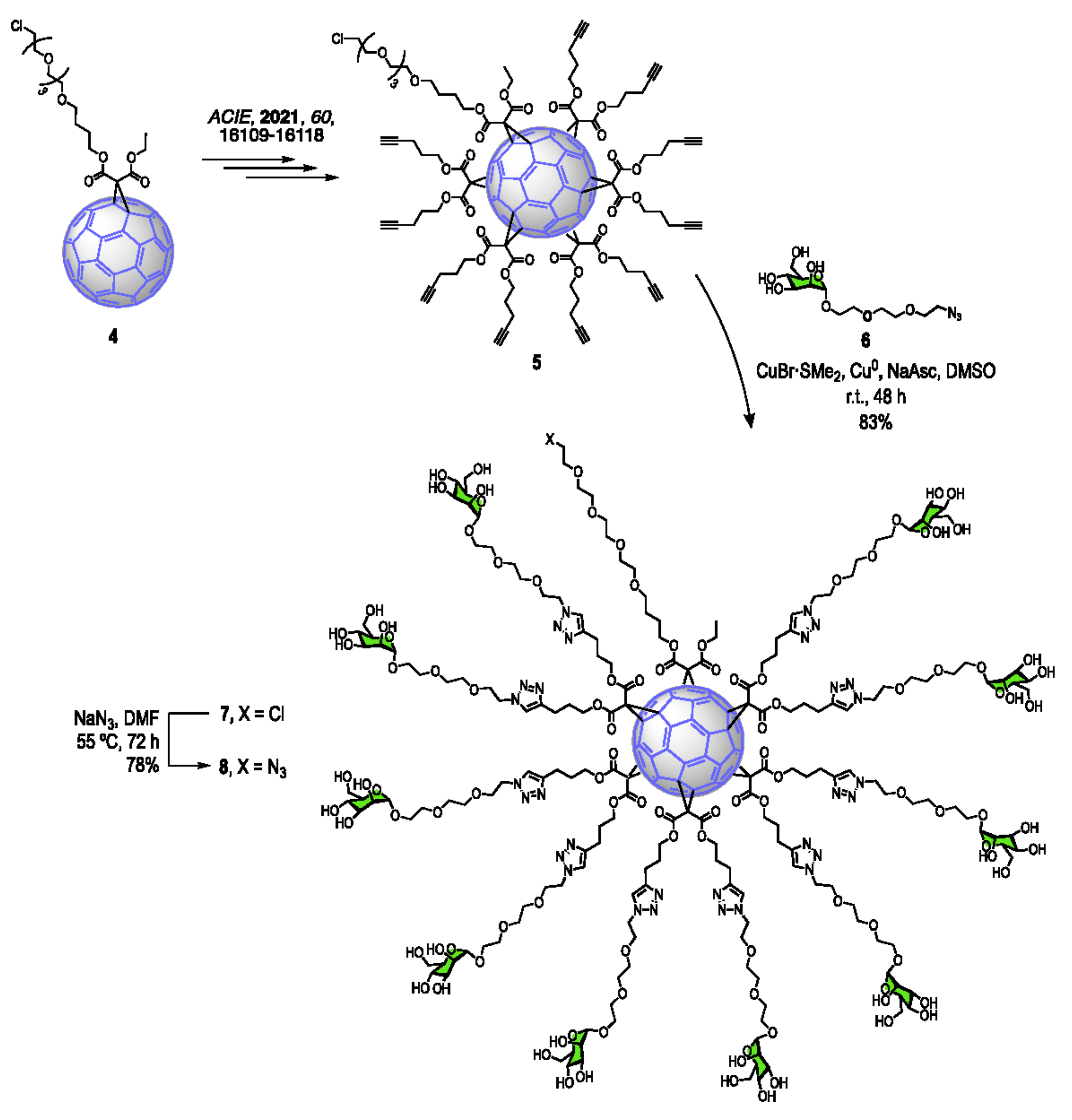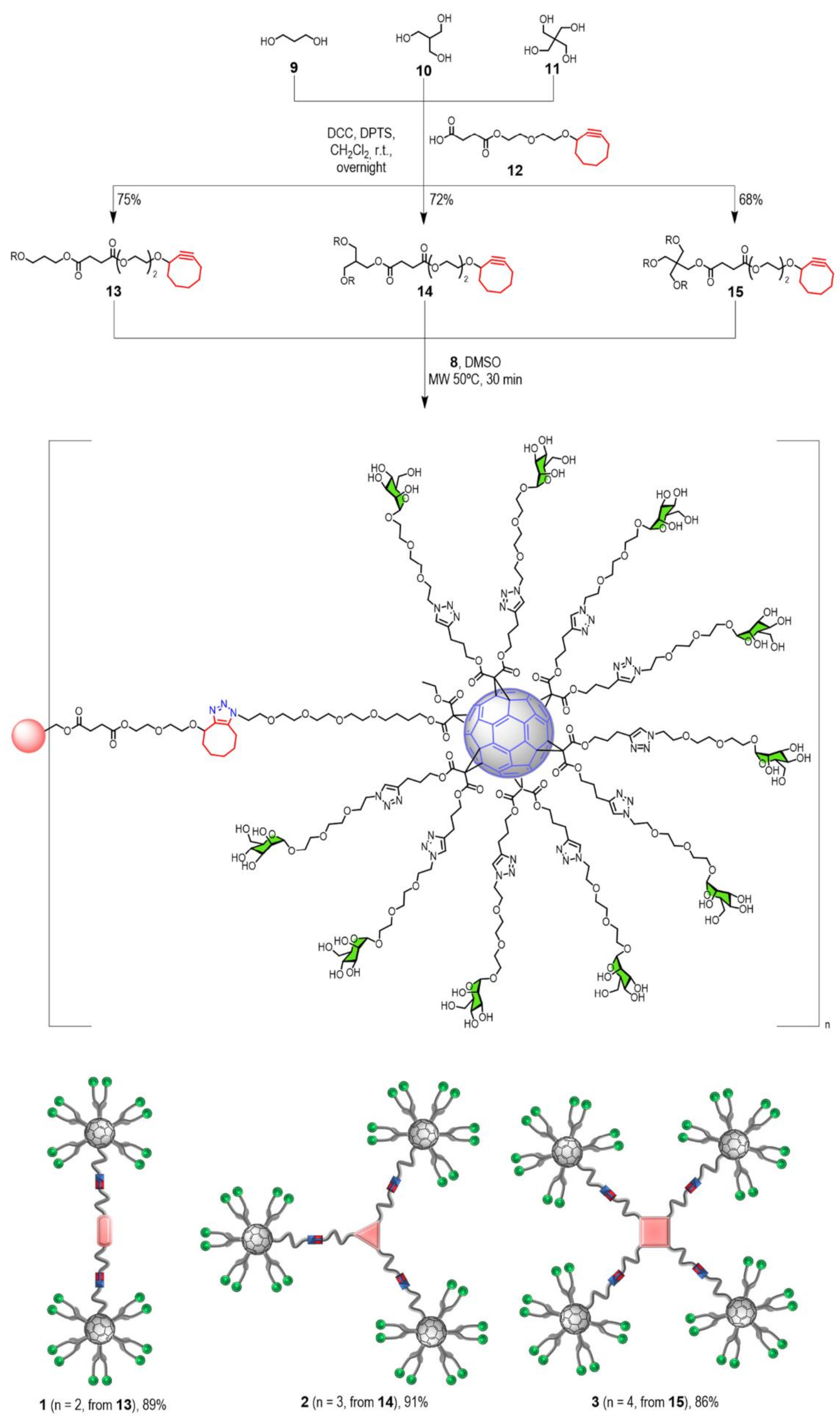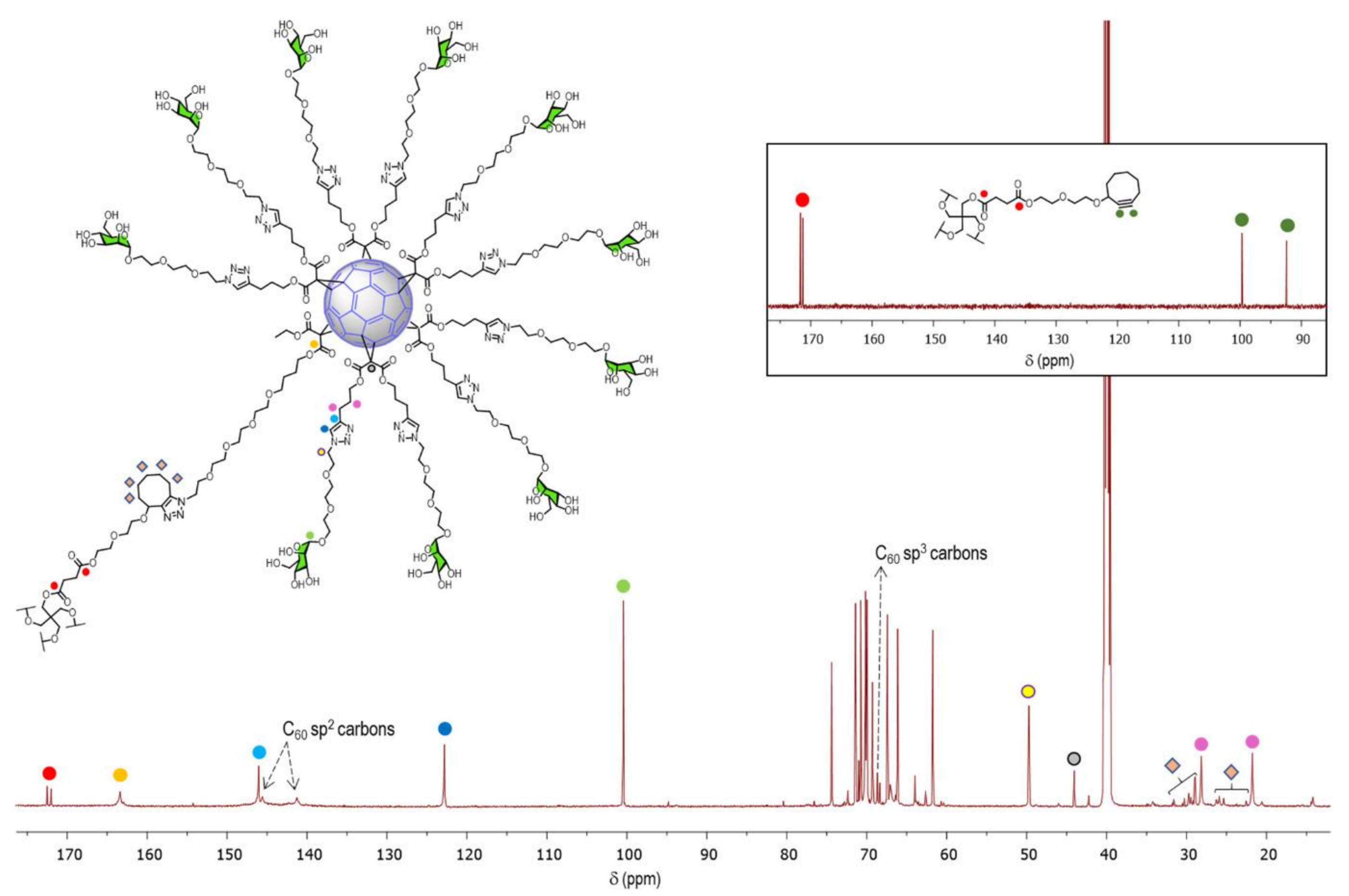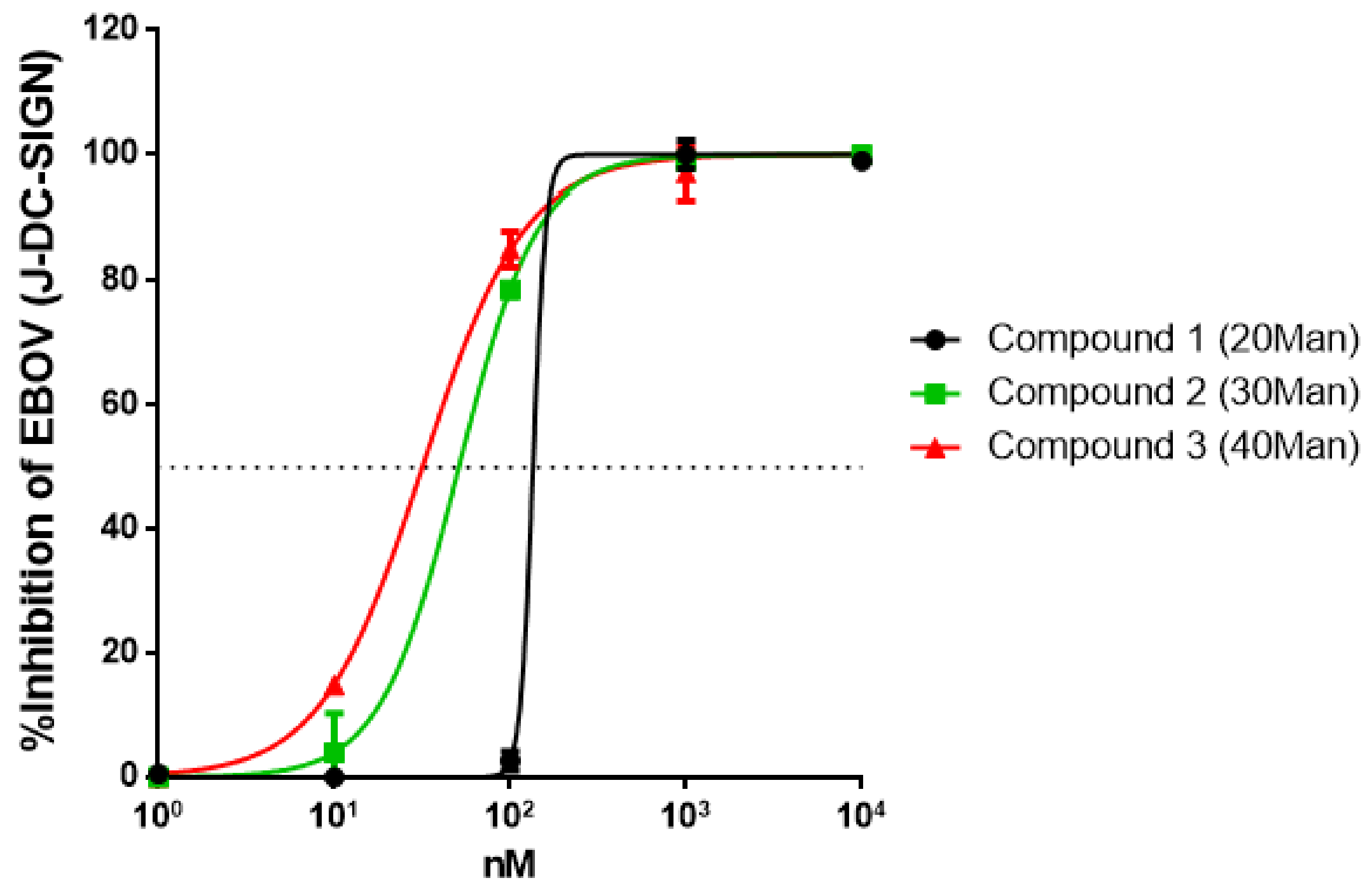Topological and Multivalent Effects in Glycofullerene Oligomers as EBOLA Virus Inhibitors
Abstract
:1. Introduction
2. Results and Discussion
2.1. Synthesis
2.2. Biological Studies
3. Materials and Methods
3.1. Synthesis
3.2. Biological Assays
Methods
- (1)
- Production of recombinant viruses
- (2)
- Infection in cis
- (3)
- Statistical analysis
4. Conclusions
Supplementary Materials
Author Contributions
Funding
Conflicts of Interest
References
- WHO. Available online: https://www.who.int/news/item/29-01-2018-high-levels-of-antibiotic-resistance-found-worldwide-new-data-shows (accessed on 28 February 2022).
- Innocenzi, P.; Stagi, L. Carbon-based antiviral nanomaterials: Graphene, C-dots, and fullerenes. A perspective. Chem. Sci. 2020, 11, 6606–6622. [Google Scholar] [CrossRef] [PubMed]
- Hurmach, V.V.; Platonov, M.O.; Prylutska, S.V.; Scharff, P.; Prylutskyy, Y.I.; Ritter, U. C60 fullerene against SARS-CoV-2 coronavirus: An in silico insight. Sci. Rep. 2021, 11, 17748. [Google Scholar] [CrossRef] [PubMed]
- Twarock, R.; Luque, A. Structural puzzles in virology solved with an overarching icosahedral design principle. Nat. Commun. 2019, 10, 4414. [Google Scholar] [CrossRef] [PubMed]
- Dechant, P.-P.; Wardman, J.; Keef, T.; Twarock, R. Viruses and fullerenes-symmetry as a common thread? Acta Cryst. A. 2014, 70, 162–167. [Google Scholar] [CrossRef]
- Muñoz, A.; Sigwalt, D.; Illescas, B.M.; Luczkowiak, J.; Rodriguez-Perez, L.; Nierengarten, I.; Holler, M.; Remy, J.S.; Buffet, K.; Vincent, S.P.; et al. Synthesis of giant globular multivalent glycofullerenes as potent inhibitors in a model of Ebola virus infection. Nat. Chem. 2016, 8, 50–57. [Google Scholar] [CrossRef]
- Munoz, A.; Illescas, B.M.; Luczkowiak, J.; Lasala, F.; Ribeiro-Viana, R.; Rojo, J.; Delgado, R.; Martin, N. Antiviral activity of self-assembled glycodendro[60]fullerene monoadducts. J. Mater. Chem. B 2017, 5, 6566–6571. [Google Scholar] [CrossRef]
- Illescas, B.M.; Rojo, J.; Delgado, R.; Martín, N. Multivalent glycosylated nanostructures to inhibit Ebola virus infection. J. Am. Chem. Soc. 2017, 139, 6018–6025. [Google Scholar] [CrossRef]
- Ramos-Soriano, J.; Reina, J.J.; Illescas, B.M.; de la Cruz, N.; Rodriguez-Perez, L.; Lasala, F.; Rojo, J.; Delgado, R.; Martin, N. Synthesis of highly efficient multivalent disaccharide/[60]fullerene nanoballs for emergent viruses. J. Am. Chem. Soc. 2019, 141, 15403–15412. [Google Scholar] [CrossRef]
- Luczkowiak, J.; Muñoz, A.; Sánchez-Navarro, M.; Ribeiro-Viana, R.; Ginieis, A.; Illescas, B.M.; Martín, N.; Delgado, R.; Rojo, J. Glycofullerenes inhibit viral infection. Biomacromolecules 2013, 14, 431–437. [Google Scholar] [CrossRef]
- Ruiz-Santaquiteria, M.; Illescas, B.M.; Abdelnabi, R.; Boonen, A.; Mills, A.; Martí-Marí, O.; Noppen, S.; Neyts, J.; Schols, D.; Gago, F.; et al. Multivalent tryptophan- and tyrosine-containing [60]fullerene hexa-adducts as dual HIV and enterovirus A71 entry inhibitors. Chem. Eur. J. 2021, 27, 10700–10710. [Google Scholar] [CrossRef]
- Tornøe, C.W.; Christensen, C.; Meldal, M. Peptidotriazoles on solid phase: [1,2,3]-triazoles by regiospecific copper(I)-catalyzed 1,3-dipolar cycloadditions of terminal alkynes to azides. J. Org. Chem. 2002, 67, 3057–3064. [Google Scholar] [CrossRef] [PubMed]
- Rostovtsev, V.V.; Green, L.G.; Fokin, V.V.; Sharpless, K.B. A stepwise huisgen cycloaddition process: Copper(I)-catalyzed regioselective “ligation” of azides and terminal alkynes. Angew. Chem. Int. Ed. 2002, 41, 2596–2599. [Google Scholar] [CrossRef]
- Nierengarten, I.; Nierengarten, J.F. The impact of copper-catalyzed alkyne-azide 1,3-dipolar cycloaddition in fullerene chemistry. Chem. Rec. 2015, 15, 31–51. [Google Scholar] [CrossRef] [PubMed]
- Agard, N.J.; Prescher, J.A.; Bertozzi, C.R. A strain-promoted [3 + 2] azide−alkyne cycloaddition for covalent modification of biomolecules in living systems. J. Am. Chem. Soc. 2004, 126, 15046–15047. [Google Scholar] [CrossRef]
- Ornelas, C.; Broichhagen, J.; Weck, M. Strain-promoted alkyne azide cycloaddition for the functionalization of poly(amide)-based dendrons and dendrimers. J. Am. Chem. Soc. 2010, 132, 3923–3931. [Google Scholar] [CrossRef]
- Dommerholt, J.; Rutjes, F.P.J.T.; van Delft, F.L. Strain-promoted 1,3-dipolar cycloaddition of cycloalkynes and organic azides. Top. Curr. Chem. 2016, 374, 16. [Google Scholar] [CrossRef]
- Ramos-Soriano, J.; Reina, J.J.; Perez-Sanchez, A.; Illescas, B.M.; Rojo, J.; Martin, N. Cyclooctyne [60]fullerene hexakis adducts: A globular scaffold for copper-free click chemistry. Chem. Commun. 2016, 52, 10544–10546. [Google Scholar] [CrossRef]
- Ramos-Soriano, J.; Reina, J.J.; Illescas, B.M.; Rojo, J.; Martin, N. Maleimide and cyclooctyne-based hexakis-adducts of fullerene: Multivalent scaffolds for copper-free click chemistry on fullerenes. J. Org. Chem. 2018, 83, 1727–1736. [Google Scholar] [CrossRef]
- Alvarez, C.P.; Lasala, F.; Carrillo, J.; Muñiz, O.; Corbí, A.L.; Delgado, R. C-type lectins DC-SIGN and L-SIGN mediate cellular entry by Ebola virus in cis and in trans. J. Virol. 2002, 76, 6841–6844. [Google Scholar] [CrossRef]
- Feinberg, H.; Mitchell, D.A.; Drickamer, K.; Weis, W.I. Structural basis for selective recognition of oligosaccharides by DC-SIGN and DC-SIGNR. Science 2001, 294, 2163–2166. [Google Scholar] [CrossRef]
- Tabarani, G.; Thépaut, M.; Stroebel, D.; Ebel, C.; Vivès, C.; Vachette, P.; Durand, D.; Fieschi, F. DC-SIGN neck domain is a pH-sensor controlling oligomerization: Saxs and hydrodynamic studies of extracellular domain. J. Biol. Chem. 2009, 284, 21229–21240. [Google Scholar] [CrossRef] [PubMed]
- Bernardi, A.; Jiménez-Barbero, J.; Casnati, A.; De Castro, C.; Darbre, T.; Fieschi, F.; Finne, J.; Funken, H.; Jaeger, K.-E.; Lahmann, M.; et al. Multivalent glycoconjugates as anti-pathogenic agents. Chem. Soc. Rev. 2013, 42, 4709–4727. [Google Scholar] [CrossRef] [PubMed]
- Ramos-Soriano, J.; Rojo, J. Glycodendritic structures as DC-SIGN binders to inhibit viral infections. Chem. Commun. 2021, 57, 5111–5126. [Google Scholar] [CrossRef] [PubMed]
- Hirsch, A.; Vostrowsky, O. C60 hexakisadducts with an octahedral addition pattern—A new structure motif in organic chemistry. Eur. J. Org. Chem. 2001, 2001, 829–848. [Google Scholar] [CrossRef]
- Ramos-Soriano, J.; Pérez-Sánchez, A.; Ramírez-Barroso, S.; Illescas, B.M.; Azmani, K.; Rodríguez-Fortea, A.; Poblet, J.M.; Hally, C.; Nonell, S.; García-Fresnadillo, D.; et al. An ultra-long-lived triplet excited state in water at room temperature: Insights on the molecular design of tridecafullerenes. Angew. Chem. Int. Ed. 2021, 60, 16109–16118. [Google Scholar] [CrossRef] [PubMed]
- Kong, N.; Shimpi, M.R.; Park, J.H.; Ramström, O.; Yan, M. Carbohydrate conjugation through microwave-assisted functionalization of single-walled carbon nanotubes using perfluorophenyl azides. Carbohydr. Res. 2015, 405, 33–38. [Google Scholar] [CrossRef]
- Isobe, H.; Cho, K.; Solin, N.; Werz, D.B.; Seeberger, P.H.; Nakamura, E. Synthesis of fullerene glycoconjugates via a copper-catalyzed huisgen cycloaddition reaction. Org. Lett. 2007, 9, 4611–4614. [Google Scholar] [CrossRef]
- Pickens, C.J.; Johnson, S.N.; Pressnall, M.M.; Leon, M.A.; Berkland, C.J. Practical considerations, challenges, and limitations of bioconjugation via azide–alkyne cycloaddition. Bioconj. Chem. 2018, 29, 686–701. [Google Scholar] [CrossRef]
- Agard, N.J.; Baskin, J.M.; Prescher, J.A.; Lo, A.; Bertozzi, C.R. A comparative study of bioorthogonal reactions with azides. ACS Chem. Biol. 2006, 1, 644–648. [Google Scholar] [CrossRef]
- Fernández-Suárez, M.; Baruah, H.; Martínez-Hernández, L.; Xie, K.T.; Baskin, J.M.; Bertozzi, C.R.; Ting, A.Y. Redirecting lipoic acid ligase for cell surface protein labeling with small-molecule probes. Nat. Biotechnol. 2007, 25, 1483–1487. [Google Scholar] [CrossRef]
- Link, A.J.; Vink, M.K.S.; Agard, N.J.; Prescher, J.A.; Bertozzi, C.R.; Tirrell, D.A. Discovery of aminoacyl-tRNA synthetase activity through cell-surface display of noncanonical amino acids. Proc. Natl. Acad. Sci. USA 2006, 103, 10180. [Google Scholar] [CrossRef] [PubMed]
- Chang, P.V.; Prescher, J.A.; Sletten, E.M.; Baskin, J.M.; Miller, I.A.; Agard, N.J.; Lo, A.; Bertozzi, C.R. Copper-free click chemistry in living animals. Proc. Natl. Acad. Sci. USA 2010, 107, 1821–1826. [Google Scholar] [CrossRef] [PubMed]
- Laughlin, S.T.; Baskin, J.M.; Amacher, S.L.; Bertozzi, C.R. In vivo imaging of membrane-associated glycans in developing zebrafish. Science 2008, 320, 664–667. [Google Scholar] [CrossRef] [PubMed]
- Carpenter, R.D.; Hausner, S.H.; Sutcliffe, J.L. Copper-Free Click for PET: Rapid 1,3-Dipolar Cycloadditions with a Fluorine-18 Cyclooctyne. ACS Med. Chem. Lett. 2011, 2, 885–889. [Google Scholar] [CrossRef] [PubMed]
- Kim, H.L.; Sachin, K.; Jeong, H.J.; Choi, W.; Lee, H.S.; Kim, D.W. F-18 labeled RGD probes based on bioorthogonal strain-promoted click reaction for PET imaging. ACS Med. Chem. Lett. 2015, 6, 402–407. [Google Scholar] [CrossRef]
- Sigwalt, D.; Caballero, R.; Holler, M.; Strub, J.-M.; Van Dorsselaer, A.; Nierengarten, J.-F. Ultra-fast dendritic growth based on the grafting of fullerene hexa-adduct macromonomers onto a fullerene core. Eur. J. Org. Chem. 2016, 2016, 2882–2887. [Google Scholar] [CrossRef]
- Harvey, D.J. Matrix-assisted laser desorption/ionization mass spectrometry of carbohydrates. Mass Spectrom. Rev. 2000, 18, 349–450. [Google Scholar] [CrossRef]
- Nyakatura, E.K.; Frei, J.C.; Lai, J.R. Chemical and structural aspects of Ebola virus entry inhibitors. ACS Infect. Dis. 2015, 1, 42–52. [Google Scholar] [CrossRef]
- Lasala, F.; Arce, E.; Otero, J.R.; Rojo, J.; Delgado, R. Mannosyl glycodendritic structure inhibits DC-SIGN-mediated Ebola virus infection in cis and in trans. Antimicrob. Agents Chemother. 2003, 47, 3970–3972. [Google Scholar] [CrossRef]
- Ribeiro-Viana, R.; Sánchez-Navarro, M.; Luczkowiak, J.; Koeppe, J.R.; Delgado, R.; Rojo, J.; Davis, B.G. Virus-like glycodendrinanoparticles displaying quasi-equivalent nested polyvalency upon glycoprotein platforms potently block viral infection. Nat. Commun. 2012, 3, 1303. [Google Scholar] [CrossRef]
- Wen, H.-C.; Lin, C.-H.; Huang, J.-S.; Tsai, C.-L.; Chen, T.-F.; Wang, S.-K. Selective targeting of DC-SIGN by controlling the oligomannose pattern on a polyproline tetra-helix macrocycle scaffold. Chem. Commun. 2019, 55, 9124–9127. [Google Scholar] [CrossRef] [PubMed]
- Goti, G.; Colombo, C.; Achilli, S.; Vivès, C.; Thépaut, m.; Fieschi, F.; Bernardi, A. Structure-based design of glycodendrimer antagonists for improved DC-SIGN targeting. ChemRxiv 2020. [Google Scholar] [CrossRef]





| Compound a | IC50 (nM) | n Mannoses | RIP b | Ref. |
|---|---|---|---|---|
| GF1LL c,d (120 Man) | 0.67 | 120 | 15800 | 6 |
| VLP e (1620 Man) | 0.91 | 1620 | 860 | 41 |
| VLP e (540 Man) | 9.62 | 540 | 244 | 41 |
| GF2 (120 Man) | 20.37 | 120 | 520 | 6 |
| 3 (40 Man) | 32 | 40 | 992 | This paper |
| 2 (30 Man) | 51 | 30 | 830 | This paper |
| 1 (20 Man) | 135 | 20 | 470 | This paper |
| C60LL d (36 Man) | 300 | 36 | 117 | 10 |
| C60 (12 Man) | 2000 | 12 | 53 | 10 |
| C60 (36 Man) | 68000 | 36 | 0.5 | 10 |
| α-Methyl Man f | 1.27 × 106 | 1 | 1 | 40 |
Publisher’s Note: MDPI stays neutral with regard to jurisdictional claims in published maps and institutional affiliations. |
© 2022 by the authors. Licensee MDPI, Basel, Switzerland. This article is an open access article distributed under the terms and conditions of the Creative Commons Attribution (CC BY) license (https://creativecommons.org/licenses/by/4.0/).
Share and Cite
Ramos-Soriano, J.; Illescas, B.M.; Pérez-Sánchez, A.; Sánchez-Bento, R.; Lasala, F.; Rojo, J.; Delgado, R.; Martín, N. Topological and Multivalent Effects in Glycofullerene Oligomers as EBOLA Virus Inhibitors. Int. J. Mol. Sci. 2022, 23, 5083. https://doi.org/10.3390/ijms23095083
Ramos-Soriano J, Illescas BM, Pérez-Sánchez A, Sánchez-Bento R, Lasala F, Rojo J, Delgado R, Martín N. Topological and Multivalent Effects in Glycofullerene Oligomers as EBOLA Virus Inhibitors. International Journal of Molecular Sciences. 2022; 23(9):5083. https://doi.org/10.3390/ijms23095083
Chicago/Turabian StyleRamos-Soriano, Javier, Beatriz M. Illescas, Alfonso Pérez-Sánchez, Raquel Sánchez-Bento, Fátima Lasala, Javier Rojo, Rafael Delgado, and Nazario Martín. 2022. "Topological and Multivalent Effects in Glycofullerene Oligomers as EBOLA Virus Inhibitors" International Journal of Molecular Sciences 23, no. 9: 5083. https://doi.org/10.3390/ijms23095083
APA StyleRamos-Soriano, J., Illescas, B. M., Pérez-Sánchez, A., Sánchez-Bento, R., Lasala, F., Rojo, J., Delgado, R., & Martín, N. (2022). Topological and Multivalent Effects in Glycofullerene Oligomers as EBOLA Virus Inhibitors. International Journal of Molecular Sciences, 23(9), 5083. https://doi.org/10.3390/ijms23095083








